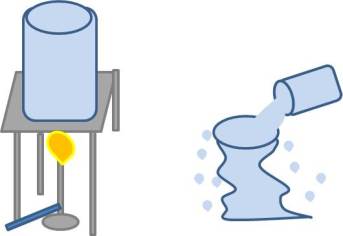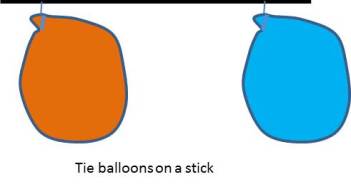Notes of chapter: Winds, Storms and Cyclones are presented below. Indepth notes along with worksheets and NCERT Solutions for Class 7.
(1) Wind-
Movement of the air in a particular direction is called wind.
(2) Air pressure or atmospheric pressure-
The pressure which is exerted by air (gases of atmosphere) on the Earth due to weight of the air is known as air pressure or atmospheric pressure.
It can be measured by the barometer.
Experiment
Take a tin can or plastic bottle with a lid or cap. Fill them half with water. Boil the water. Put the lid on the can immediately. Put the can in washbasin and pour fresh water on it. The shape of the can changed. It happens due to condensation of steam in water that reduces the amount of the air inside the can. The pressure of air inside the can decreases than the air pressure outside the can. So, the can gets compressed.

Can with hot water being cooled down
Eg:-Some daily life examples which show air exerts pressure are given below:
(i) It is easy to row a boat if wind is coming behind us because air exerts pressure that helps us to row a boat.
(ii)It is easy to fly a kite if wind is coming from the back of us because air exerts pressure that helps us to fly a kite.
(iii) It is difficult to ride a bicycle in the opposite direction of the wind because air pressure exerts in opposite direction and we have to put force to ride it.
(iv) We fill air into the bicycle tube to keep it tight. We have to put less force if tube is tight with air.
(3) Air move from high pressure area to low pressure area which results decrease or reduction in air pressure of the high pressure area. Thus, high speed winds are accompanied by reduced air pressure. The greater the difference in pressure, the faster the air moves.
Experiment 1
Take a plastic bottle and a ball of crumble paper smaller than the size of mouth of the bottle. Put ball just inside the bottle. Now blow on the ball to force it into the bottle. Ball does not fall into bottle. Because, when we blow into the mouth of the bottle, the air near the mouth has high speed that decreases the pressure there. The pressure inside the bottle is higher than the pressure near the mouth. So, the ball is pushed outside by the inside pressure.

Experiment 2
Take two balloons of equal size. Fill little water into them. Now blow them up. Hang them on a stick 8-10cm apart. Blow in the space between them. Both balloons moved towards each other. It could happen if air pressure outside the balloons is greater than the air pressure inside them. The outside air pressure would push them toward each other.


Experiment 3
Blow over a paper strip of 20 cm long and 3 cm wide. It went upwards because blowing over the paper reduces the air pressure above the strip.
We can conclude from above experiments that increased wind speed is accompanied by a reduced air pressure.


Eg:- If high speed wind blows over the weak roof it can lift the roof of the building. High speed of wind decreases the air pressure over the roof. The air pressure inside the house is high. Hence, roof of the house can be lifted by the high air pressure of inside the house.
(4)After heating air expands and occupy more space because of increasing kinetic energy of molecules of air. Hot air is less dense. Therefore, it is lighter than cold air.
Experiment 1
Tight a balloon on the boiling tube. Put it in the hot water. The balloon fill inflated by the hot air. Air expands on heating and occupies more space. Hence, the boiling tube inflated. Now, put this tube in the ice- cold water. The balloon will deflated by the cold air. The cold air condenses on cooling and occupies less space.
Experiment 2
Tie two paper bags upside down of same size on a stick. Put a thread in the middle of the stick. Hold stick with thread as a balance. Put a burning candle below one bag. After some time balance of stick disturbed and it moves downward in the direction of the other bag. The hot air expands and occupies more space. Hence, warm air is lighter than the cold air.


Eg:-
(i)Land breeze travels from land to sea when hot air of the sea rises up and wind from the land occupies the place over the sea.
(ii) Sea breeze travels from sea to land when hot air of the land rises up and wind from the sea occupies the place over the land.
(iii) Hot air balloon rises up because hot air of balloon expands and rises up to occupy more space.
(iv) Smoke always rises up because it expands and rises up to occupy more space.
(v) Wind current (storm) generated due to uneven heating on the earth.
(5)Different situations of wind current generated due to uneven heating on the earth.
(i) Uneven heating between the equator and the poles-
The regions close to equator gets hot by the sun. Hot air rises up and the cold air from the North and south poles (0-30degrrss latitude) rushes in. The winds would have flown in the north – south direction or south – north direction. A change in direction is caused by the rotation of the earth.
(ii) Uneven heating of land and water-
The land warms up faster than the oceans in summer near the equator. The air above the land warms and rises up. The comparatively cold air of oceans moves towards land to take place of warm air. These are monsoon winds. It brings rain. It is part of the water cycle. The word `monsoon’ is derived from the Arabic word `mausam’, which means `seasons’.
The winds move from land to ocean in winter because air above sea cools slowly. As the result air rises up and expands and more cool air above land come over sea.
(6) The rain helps in
(i) irrigation
(ii) lowering temperature of weather
(iii) increasing underground water table
(iv) filling ponds and water resources .
(7) Problems created by the rain are given below-
(i) Flood
(ii)Mire(mud)
(iii) Water logging
(8) Thunderstorm-
A small severe weather with thunder, lightning, and sometime with rain and hail is called thunderstorm.
The rising temperature of the land produces strong upwards rising winds that caries water droplets. These droplets condense there and fall down as rain. The swift movement of the failing water droplets along with rising air create lightening and sound.
(9)Precautions taken at the time of thunder are given below-
(i) Do not take shelter under an isolated tree. Take shelter under a small tree.
(ii) Do not lie on the ground.
(iii)Do not use umbrella with a metallic end.
(iv) Do not sit near a window.
(v) Do not take shelter under open garages, storages sheds, metal sheds.
(vi) A car or a bus is a safe place to take shelter.
(vii) Do not go into water. But go in the building.
(10) Cyclones-
Cyclones are the high speed winds with low atmospheric pressure around the centre of storm.
Water takes heat from the atmosphere to change into vapour. When these vapours change in to liquid as raindrops it releases the heat to the atmosphere and warms the air around. The air rises up and crate low pressure. Hence, more air rushes to the centre of the storm.
Centre of storm is a point where atmospheric pressure is the lowest.
Wind speed, wind direction, temperature and humidity are different factors which contribute to the development of cyclones.
(11) A cyclone is known by different names in different parts of the world. Some are given in the table below:
| S.N. | Name of the country | Name of the cyclone |
| 1. | America | Hurricane |
| 2. | Philippines
|
Typhoon |
| 3. | Japan | Typhoon |
(12) Destructions caused by cyclones are given below-
(i) Strong winds can push water towards shore even if the storm is hundreds of kilometers away. Coming of water towards the shore is the first indication of approaching cyclone.
(ii)The eye of cyclone (center of the cyclone) has low pressure that lifts water surface in the center at the height o f3-12 metres. It looks like a moving water wall towards the shore. Hence, water enters the low- lying coastal areas that causes loss of many life and property.
(iii) It may further worsen the flood situation.
(iv) It can damage houses, telephone and other communication system, trees.
(13) Effective safety measures from the cyclone are given below-
(i)A cyclone forecast and warning service is necessary for the people who live near the coastline.
(ii)Rapid communication of warnings to the Government agencies, the ports, fishermen, ships and to the general public is necessary.
(iii) Construction of cyclone shelters in the cyclone prone area and the administrative arrangement is necessary.
(14)Action on the part of the people of cyclone prone area-
(i) We should not ignore the warnings issued by the meteorological department through TV, radio, or newspapers.
(ii)We should make necessary arrangement to shift household items and cattle to the safer place.
(iii) We should not drive through standing water as floods may have damaged eh road.
(iv)We should have phone numbers of emergency services as fire brigade, hospitals and police.
(v)We should not drink water as it can be contaminated.
(vi) We should not touch wet switches and fallen electric line.
(vii)We should not pressurise the rescue team by making undue demands.
(ix) We should help our neighbours and friends.
(15) Tornado-
Tornado is a dark funnel shaped cloud that reaches from the sky to the ground with a varying diameter from meter to kilometer.
It sucks everything near it.
It can travel at speeds of about 300 km/h.
It can be form within the cyclones.
The west coastline of India is less vulnerable to cyclonic storm then east coast line in terms of intensity and frequency of the cyclones.
(16) An anemometer is used to measure the speed of the wind.
(17)Satellite and radars issues cyclone alert or cyclone watch in 48 hours advance.
A cyclone warning is issued 24 hours in advance.
The people are informed by broadcasting the message every hour or half hour when a cyclone is near to the coast.
Several national and international organizations cooperate to monitor the cyclone related disasters.
Helping Topics


